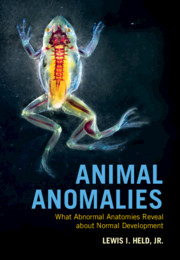‘With rigorous arguments presented in captivating prose and crystal-clear drawings so rich in information, this new masterpiece by Lewis Held is a unique introduction to the genetics of development. Here, monstrous and normal illuminate each other, as products of the same developmental logic. This book is full of inspiring insights, on a par with the works of the great developmental biologists highlighted in its pages.’
Alessandro Minelli - University of Padova, Italy, and author of Understanding Development
‘Orthodoxy is so rife in science these days it is strangling originality. The spread of ’best practice’ as well as the related belief that there is only one ideal way to understand and explain things has stifled both diversity and imagination. … Lewis Held shows us there is another way - to look at the natural world open-mouthed and open-minded. We are taken on a lively ramble through myriad natural phenomena in countless species and the attempts of scientists to understand them. There is an infectious sense of the wonder and complexity of everything. There are innumerable nuggets to be found and it is fun. … His book sings like the descant in a choral rendition of a familiar hymn. I recommend it, but don’t try and read it all in one go!’
Peter A. Lawrence - University of Cambridge, UK
‘In this wonderful exploration of development, Lewis Held uses both familiar and less-well-known examples of frogs, flies, dogs, and cats to delve deeply into the underlying biological principles their traits can illustrate … Held also describes the genetic basis of traits that pet-owners find endearing … In addition to this fascinating exploration of genetic mechanisms and their outcomes is another idea that I have always valued in Lewis Held’s work: the respect for pioneering insights and discoveries by earlier researchers like Curt Stern, Walter Gehring, Ernst Hadorn, and others. I remember hearing a faculty advisor once criticize a new graduate student for planning to cite a research article that was more than a couple years old as being irrelevant to ‘modern research’. Thankfully, writers like Held remind us that the story of discovery is a long one, and critical insights can come from anywhere.’
Jim Thompson
Source: Drosophila Information Service
‘Recommended. Graduate students and faculty.’
D. A. Brass
Source: Choice
‘The volume is a very readable deep dive, written as a romp through a series of mysteries and associated detective stories, some of which have been fully solved, others not … Held is able to provide detailed explanations of the underlying developmental-genetic mechanisms that produce the variation … because he assumes a basic knowledge of cell signaling mechanisms, he is able to present the information at a much deeper level than most popular evo-devo books can … the volume should interest a wide range of readers, from advanced undergraduates through emeritus professors.’
John Reiss
Source: The Quarterly Review of Biology
‘… the diagrams are detailed and fascinating, but outstanding in Animal Anomalies are the photographs. We are all so used to the way the world ‘should’ look, we can’t help but be stopped in our tracks when confronted with something so unexpected as, for instance, an otherwise healthy frog who, mouth open, shows us its eyes looking out from the roof of its mouth. … Animal Anomalies is a breathtaking sweep of ‘things gone wrong,’ that all illuminate some of the critical steps in normal animal development.’
Mark Terry
Source: American Biology Teacher





